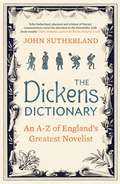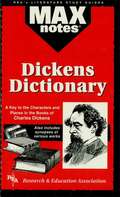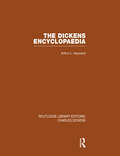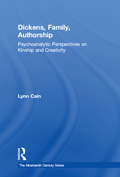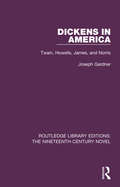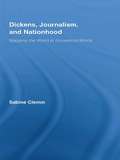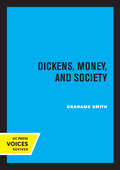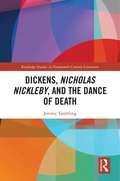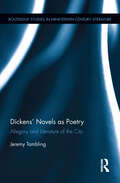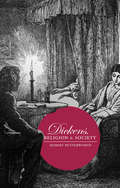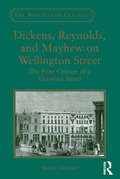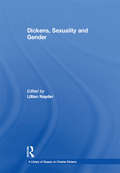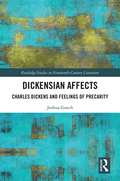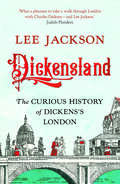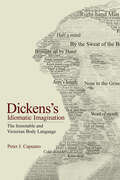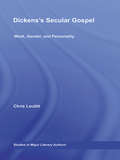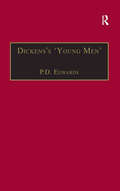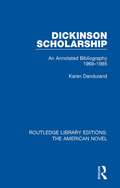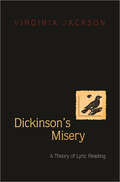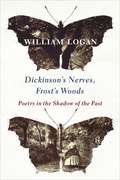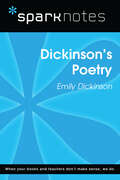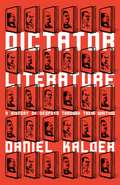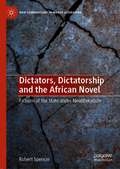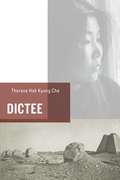- Table View
- List View
Dickens Dictionary: An A-Z of England's Greatest Novelist
by John SutherlandFROM THE BOOK JACKET: For fans old and new, this is a fascinating tour through Charles Dickens's novels, in the hands of a master critic and -- interpreter of his work. Oliver Twist... Great Expectations... David Copperfield - all contain riotous fictional worlds that still live and breathe for readers today. But how much do we really know about the dazzling imagination that brought them all into being? To celebrate the bicentenary of the birth of Dickens in 2012, Victorian literature expert John Sutherland has created a gloriously wide-ranging alphabetical companion to Dickens's novels, excavating the hidden links between his characters, themes, and preoccupations, and the minutiae of his endlessly inventive wordplay.
Dickens Dictionary (MAXNotes Literature Guides)
by Editors of REA Alex PhillipsREA's MAXnotes Dickens Dictionary The MAXNotes Dickens Dictionary is your key to the places and characters in the books of Charles Dickens. This text includes synopses of each of Dickens's works, both major and minor, along with dictionary style entries referring to the body of work as a whole. A must for any student of Dickens.
The Dickens Encyclopaedia: Routledge Library Editions: Charles Dickens Volume 8 (Routledge Library Editions: Charles Dickens #Vol. 8)
by Arthur L. HaywardThis is the standard reference guide to the works of Charles Dickens. The material is arranged alphabetically, in dictionary style, and provides a quick means of reference to the plots of the novels and to all the characters and places mentioned in the novels. There are also useful explanatory notes on allusions and phrases.
Dickens, Family, Authorship: Psychoanalytic Perspectives on Kinship and Creativity (The Nineteenth Century Series)
by Lynn CainDrawing on a wide range of Dickens's writings, including all of his novels and a selection of his letters, journalism, and shorter fiction, Dickens, Family, Authorship provides a provocative account of the evolution of an author from whose psychological honesty and imaginative generosity emerged precocious fictional portents of Freudian and post-Freudian theory. The decade 1843-1853 was pivotal in Dickens's career. A phase of feverish activity on both personal and professional fronts, it included the irrevocable souring of his relations with his parents, the peripatetic residence in continental Europe, and a massive proliferation of writing and editing activities including the aborted autobiography. It was a period of astounding creativity which consolidated Dickens's authorial and financial stature. It was also one tainted by loss: the deaths of his father, sister and daughter, and the alarming desertion of his early facility for composition. Lynn Cain's substantial study of the four novels produced during this turbulent decade - Martin Chuzzlewit, Dombey and Son, David Copperfield and Bleak House - traces the evolution of Dickens's creative imagination to discover in the modulating fictional representation of family relationships a paradigm for his authorial development. Closely argued readings demonstrate a reorientation from a patriarchal to a maternal dynamic which signals a radical shift in Dickens's creative technique. Interweaving critical analysis of the four novels with biography and the linguistic and psychoanalytic writings of modern theorists, especially Kristeva and Lacan, Lynn Cain explores the connection between Dickens's susceptibility to depression during this period and his increasingly self-conscious exploitation of his own mental states in his fiction.
Dickens in America: Twain, Howells, James, and Norris (Routledge Library Editions: The Nineteenth-Century Novel #15)
by Joseph GardnerFirst published in 1988, this book looks at the enormous impact Dickens’ writings had on American novelists in the second half of the nineteenth century. Dickens dominated not only popular taste but the American novel for sixty years and the author argues that even the most original writers showed themselves again and again to be in ‘conscious sympathy’ with Dickens. Along with Dickens, this book examines four radically different American writers — Mark Twain, William Dean Howells, Henry James and Frank Norris — whose debt to Dickens, the author asserts, is nevertheless clearly evident in their work. This book will be of interest to students of literature.
Dickens, Journalism, and Nationhood: Mapping the World in Household Words (Studies in Major Literary Authors)
by Sabine ClemmDickens, Journalism, and Nationhood examines Charles Dickens’ weekly family magazine Household Words in order to develop a detailed picture of how the journal negotiated, asserted and simultaneously deconstructed Englishness as a unified (and sometimes unifying) mode of expression. It offers close readings of a wide range of materials that self-consciously focus on the nature of England as well as the relationship between Britain and the European continent, Ireland, and the British colonies. Starting with the representation and classification of identities that took place within the framework of the Great Exhibition of 1851, it suggests that the journal strives for a model of the world in concentric circles, spiraling outward from the metropolitan center of London. Despite this apparent orderliness, however, each of the national or regional categories constructed by the journal also resists and undermines such a clear-cut representation.
Dickens, Money, and Society
by Grahame SmithThis title is part of UC Press's Voices Revived program, which commemorates University of California Press’s mission to seek out and cultivate the brightest minds and give them voice, reach, and impact. Drawing on a backlist dating to 1893, Voices Revived makes high-quality, peer-reviewed scholarship accessible once again using print-on-demand technology. This title was originally published in 1968.
Dickens, Nicholas Nickleby, and the Dance of Death (Routledge Studies in Nineteenth Century Literature)
by Jeremy TamblingThis study of Nicholas Nickleby takes the Dickens novel which is perhaps the least critically discussed, though it is very popular, and examines its appeal and its significance, and finds it one of the most rewarding and powerful of Dickens’s texts. Nicholas Nickleby deals with the abduction and destruction of children, often with the collusion of their parents. It concentrates on this theme in a way which continues from Oliver Twist, describing such oppression, and the resistance to it, in the language of melodrama, of parody and comedy. With chapters on the school-system that Dickens attacks, and its grotesque embodiment in Squeers, and with discussion of how the novel reshapes eighteenth century literary traditions, and such topics as the novel’s comedy, and the concept of the ‘humorist’; and ‘theatricality’ and its debt to Carlyle,, the book delves into the way that the novel explores madness within the city in those whose lives have been fractured, or ruined, as so many have been, and considers the symptoms of hypocrisy in the lives of the oppressors and the oppressed alike; taking hypocrisy as a Dickensian subject which deserves further examination. Dickens, Nicholas Nickleby, and the Dance of Death explores ways in which Dickens draws on medieval and baroque traditions in how he analyses death and its grotesquerie, especially drawing on the visual tradition of the ‘dance of death’ which is referred to here and which is prevalent throughout Dickens’s novels. It shows these traditions to be at the heart of London, and aims to illuminate a strand within Dickens’s thinking from first to last. Drawing on the critical theory of Walter Benjamin, Freud, Nietzsche and Marx, and with close detailed readings of such well-known figures as Mrs Nickleby, Vincent Crummles and his theatrical troupe, and Mr Mantalini, and attention to Dickens’s description, imagery, irony, and sense of the singular, this book is a major study which will help in the revaluation of Dickens’s early novels.
Dickens' Novels as Poetry: Allegory and Literature of the City (Routledge Studies in Nineteenth Century Literature)
by Jeremy TamblingFocusing on the language, style, and poetry of Dickens’ novels, this study breaks new ground in reading Dickens’ novels as a unique form of poetry. Dickens’ writing disallows the statement of single unambiguous truths and shows unconscious processes burrowing within language, disrupting received ideas and modes of living. Arguing that Dickens, within nineteenth-century modernity, sees language as always double, Tambling draws on a wide range of Victorian texts and current critical theory to explore Dickens’ interest in literature and popular song, and what happens in jokes, in caricature, in word-play and punning, and in naming. Working from Dickens’ earliest writings to the latest, deftly combining theory with close analysis of texts, the book examines Dickens’ key novels, such as Pickwick Papers, Martin Chuzzlewit, Dombey and Son, Bleak House, Little Dorrit, Great Expectations, and Our Mutual Friend. It considers Dickens as constructing an urban poetry, alert to language coming from sources beyond the individual, and relating that to the dream-life of characters, who both can and cannot awake to fuller, different consciousness. Drawing on Walter Benjamin, Lacan, and Derrida, Tambling shows how Dickens writes a new and comic poetry of the city, and that the language constitutes an unconscious and secret autobiography. This volume takes Dickens scholarship in exciting new directions and will be of interest to all readers of nineteenth-century literary and cultural studies, and more widely, to all readers of literature.
Dickens, Religion and Society
by Robert ButterworthDickens, Religion and Society examines the centrality of Dickens's religious attitudes to the social criticism he is famous for, shedding new light in the process on such matters as the presentation of Fagin as a villainous Jew, the hostile portrayal of trade unions in Hard Times and Dickens's sentimentality.
Dickens, Reynolds, and Mayhew on Wellington Street: The Print Culture of a Victorian Street (The Nineteenth Century Series)
by Mary L. ShannonA glance over the back pages of mid-nineteenth-century newspapers and periodicals published in London reveals that Wellington Street stands out among imprint addresses. Between 1843 and 1853, Household Words, Reynolds’s Weekly Newspaper, the Examiner, Punch, the Athenaeum, the Spectator, the Morning Post, and the serial edition of London Labour and the London Poor, to name a few, were all published from this short street off the Strand. Mary L. Shannon identifies, for the first time, the close proximity of the offices of Charles Dickens, G.W.M. Reynolds, and Henry Mayhew, examining the ramifications for the individual authors and for nineteenth-century publishing. What are the implications of Charles Dickens, his arch-competitor the radical publisher G.W.M. Reynolds, and Henry Mayhew being such close neighbours? Given that London was capital of more than Britain alone, what connections does Wellington Street reveal between London print networks and the print culture and networks of the wider empire? How might the editors’ experiences make us rethink the ways in which they and others addressed their anonymous readers as ’friends’, as if they were part of their immediate social network? As Shannon shows, readers in the London of the 1840s and '50s, despite advances in literacy, print technology, and communications, were not simply an ’imagined community’ of individuals who read in silent privacy, but active members of an imagined network that punctured the anonymity of the teeming city and even the empire.
Dickens, Sexuality and Gender (A Library of Essays on Charles Dickens)
by Lillian NayderThis volume of essays examines Dickens's complex representations of sexuality and gender as well as his use of gender ideologies and sexual and gender differences over the course of his literary career, from his first sketches and early novels to his late works of fiction. The essays approach gender issues in Dickens's writing by focusing on a number of topics: his treatment of gender ideals and transgressions; the intersections and displacements among gender, class and race; the ties between gender and the body, and among gender, voice and language; his depiction of the homosocial and the homoerotic; and the relation between gender and the law. The essays provide an introduction to the most recent approaches to Dickens's fiction in addition to those now considered classic, draw on queer theory and also feature a variety of methodologies, ranging across feminist, historicist and psychoanalytic methods of interpretation. The collection represents the best of previously published research by Dickens's scholars and illuminates for students and scholars alike the meaning of gender in such novels as The Pickwick Papers, Dombey and Son, and Our Mutual Friend.
Dickensian Affects: Charles Dickens and Feelings of Precarity (Routledge Studies in Nineteenth Century Literature)
by Joshua GoochIn Dickensian Affects: Charles Dickens and Feelings of Precarity, Joshua Gooch argues that Dickens’s novels offer models of feeling that illuminate the dissensions that accompany life’s precariousness under capitalism. By examining the role of violence, anxiety, surprise, and suspense in Dickens’s novels, Gooch explores how they represent and shape emotions to create rhythms specific to their historical moment. To unearth Dickensian affects, Gooch examines how some of Dickens’s novels yoke elements in their difference to signal different kinds and ways of feeling, what he terms affective form. This patterning of elements links a text’s ways of feeling to its conjuncture and locates lines of flight that allow its representations of emotion to become something else. The violence of Oliver Twist links its satire of the New Poor Law to the post-abolition period of apprenticeship in the West Indies. The pervasive anxiety of The Old Curiosity Shop links Nell’s journey to arguments economic inequality focused on questions of inheritance and land reform. The surprise of David Copperfield binds its interests in questions of character and trust to Britain’s professional world and credit markets. And the suspense of Great Expectations gestures toward a sense of shame and demand for new models of masculine character also seen in the Volunteer rifle militias. Dickensian Affects argues that for Dickens, questions of feeling reveal the precarity of feeling itself. For Dickens, to feel is to know the possibility of feeling otherwise.
Dickensland: The Curious History of Dickens's London
by Lee JacksonThe intriguing history of Dickens’s London, showing how tourists have reimagined and reinvented the Dickensian metropolis for more than 150 years “Jackson paints a vivid and detailed picture of the city as it was. . . . Dickens, who was no stranger to the instructive and comedic joys of pedantry, would surely have approved.”—Ann Alicia Garza, Times Literary Supplement Tourists have sought out the landmarks, streets, and alleys of Charles Dickens’s London ever since the death of the world-renowned author. Late Victorians and Edwardians were obsessed with tracking down the locations—dubbed “Dickensland”—that famously featured in his novels. But his fans were faced with a city that was undergoing rapid redevelopment, where literary shrines were far from sacred. Over the following century, sites connected with Dickens were demolished, relocated, and reimagined. Lee Jackson traces the fascinating history of Dickensian tourism, exploring both real Victorian London and a fictional city shaped by fandom, tourism, and heritage entrepreneurs. Beginning with the late nineteenth century, Jackson investigates key sites of literary pilgrimage and their relationship with Dickens and his work, revealing hidden, reinvented, and even faked locations. From vanishing coaching inns to submerged riverside stairs, hidden burial grounds to apocryphal shops, Dickensland charts the curious history of an imaginary world.
Dickens's Idiomatic Imagination: The Inimitable and Victorian Body Language
by Peter J. CapuanoDickens's Idiomatic Imagination offers an original analysis of how Charles Dickens's use of "low" and "slangular" (his neologism) language allowed him to express and develop his most sophisticated ideas. Using a hybrid of digital (distant) and analogue (close) reading methodologies, Peter J. Capuano considers Dickens's use of bodily idioms—"right-hand man," "shoulder to the wheel," "nose to the grindstone"—against the broader lexical backdrop of the nineteenth century. Dickens was famously drawn to the vernacular language of London's streets, but this book is the first to call attention to how he employed phrases that embody actions, ideas, and social relations for specific narrative and thematic purposes. Focusing on the mid- to late career novels Dombey and Son, David Copperfield, Bleak House, Great Expectations, and Our Mutual Friend, Capuano demonstrates how Dickens came to relish using common idioms in uncommon ways and the possibilities they opened up for artistic expression. Dickens's Idiomatic Imagination establishes a unique framework within the social history of language alteration in nineteenth-century Britain for rethinking Dickens's literary trajectory and its impact on the vocabularies of generations of novelists, critics, and speakers of English.
Dickens's Secular Gospel: Work, Gender, and Personality (Studies in Major Literary Authors)
by Chris LouttitThe first full-length study on the subject of Dickens and work, this book reshapes our understanding of Dickens by challenging a critical oversimplification: that Dickens's attitude towards work reflects conventional expressions of Victorian earnestness of the sort attributed also to Thomas Carlyle, John Ruskin, and even more simplistically, Samuel Smiles. Instead, by analyzing a wide range of Dickens’s fiction and journalism in the light of new biographical and historical research, Louttit shows that Dickens is not interested in work as an abstract, positive value, or even in cataloguing it in concrete detail. What he explores instead is the human dimension of work: how, in other words, work affects the lives of those engaged in it. His writing about work is, as a result, best viewed not merely as a quasi-religious Gospel of Work, nor as an objective sociological report, but rather as what Louttit terms a "secular gospel."
Dickens's Style
by Daniel TylerCharles Dickens, generally regarded as the greatest novelist of the Victorian age, was known as 'The Inimitable', not least for his distinctive style of writing. This collection of twelve essays addresses the essential but often overlooked subject of Dickens's style, with each essay discussing a particular feature of his writing. All the essays consider Dickens's style conceptually, and they read it closely, demonstrating the ways it works on particular occasions. They show that style is not simply an aesthetic quality isolated from the deepest meanings of Dickens's fiction, but that it is inextricably involved with all kinds of historical, political and ideological concerns. Written in a lively and accessible manner by leading Dickens scholars, the collection ranges across all Dickens's writing, including the novels, journalism and letters.
Dickens’s ‘Young Men’: George Augustus Sala, Edmund Yates and the World of Victorian Journalism (The Nineteenth Century Series)
by P.D. EdwardsIn Dickens's lifetime, and for a generation or so after, Edmund Hodgson Yates and George Augustus Sala were the best known and most successful of his "young men" - the budding writers who acknowledged him as their guide and mentor and whose literary careers the publicity and privately fostered. The book considers their personal and literary relationships with Dickens, with each other, and with other writers of the period, Bohemian and "respectable", including Yates's arch-enemy, his post-office colleague Anthony Trollope. But it also demonstrates that their life and writings - their fiction, private letters and occasional essays in verse and drama, as well as their already recognised contributions to the development of the "new journalism" - are interesting and historically illuminating in their own right, not merely pale reflections of the glory of greater writers. Extensive use is made of previously unpublished material.
Dickinson Scholarship: An Annotated Bibliography 1969-1985 (Routledge Library Editions: The American Novel #4)
by Karen DandurandThis bibliography, first published in 1988, is intended to make more readily accessible the wealth of Dickinson criticism and scholarship that appeared from 1969 through 1985. During the 17 years that are covered in this bibliography nearly 800 books, articles and dissertations have appeared. The present work is intended to aid both students and scholars in finding the materials they need in their study of, and research on, Emily Dickinson’s poetry and her life.
Dickinson's Misery: A Theory of Lyric Reading
by Virginia JacksonHow do we know that Emily Dickinson wrote poems? How do we recognize a poem when we see one? In Dickinson's Misery, Virginia Jackson poses fundamental questions about reading habits we have come to take for granted. Because Dickinson's writing remained largely unpublished when she died in 1886, decisions about what it was that Dickinson wrote have been left to the editors, publishers, and critics who have brought Dickinson's work into public view. The familiar letters, notes on advertising fliers, verses on split-open envelopes, and collections of verses on personal stationery tied together with string have become the Dickinson poems celebrated since her death as exemplary lyrics. Jackson makes the larger argument that the century and a half spanning the circulation of Dickinson's work tells the story of a shift in the publication, consumption, and interpretation of lyric poetry. This shift took the form of what this book calls the "lyricization of poetry," a set of print and pedagogical practices that collapsed the variety of poetic genres into lyric as a synonym for poetry. Featuring many new illustrations from Dickinson's manuscripts, this book makes a major contribution to the study of Dickinson and of nineteenth-century American poetry. It maps out the future for new work in historical poetics and lyric theory.
Dickinson's Nerves, Frost's Woods: Poetry in the Shadow of the Past
by William LoganIn Dickinson’s Nerves, Frost’s Woods, William Logan, the noted and often controversial critic of contemporary poetry, returns to some of the greatest poems in English literature. He reveals what we may not have seen before and what his critical eye can do with what he loves. In essays that pair different poems—“Ozymandias,” “On First Looking Into Chapman’s Homer,” “In a Station of the Metro,” “The Red Wheelbarrow,” “After great pain, a formal feeling comes,” and “Stopping by Woods on a Snowy Evening,” among others—Logan reconciles history and poetry to provide new ways of reading poets ranging from Shakespeare and Shelley to Lowell and Heaney.In these striking essays, Logan presents the poetry of the past through the lens of the past, attempting to bring poems back to the world in which they were made. Logan’s criticism is informed by the material culture of that world, whether postal deliveries in Regency London, the Métro lighting in 1911 Paris, or the wheelbarrows used in 1923. Deeper knowledge of the poet’s daily existence lets us read old poems afresh, providing a new way of understanding poems now encrusted with commentary. Logan shows that criticism cannot just root blindly among the words of the poem but must live partly in a lost world, in the shadow of the poet’s life and the shadow of the age.
Dickinson's Poetry (SparkNotes Literature Guide Series)
by SparkNotesDickinson's Poetry (SparkNotes Literature Guide) by Emily Dickinson Making the reading experience fun! Created by Harvard students for students everywhere, SparkNotes is a new breed of study guide: smarter, better, faster.Geared to what today's students need to know, SparkNotes provides:chapter-by-chapter analysis explanations of key themes, motifs, and symbols a review quiz and essay topics Lively and accessible, these guides are perfect for late-night studying and writing papers.
Dictator Literature: A History of Bad Books by Terrible People
by Daniel KalderA Book of the Year for The Times and the Sunday Times &‘The writer is the engineer of the human soul,&’ claimed Stalin. Although one wonders how many found nourishment in Turkmenbashi&’s Book of the Soul (once required reading for driving tests in Turkmenistan), not to mention Stalin&’s own poetry. Certainly, to be considered great, a dictator must write, and write a lot. Mao had his Little Red Book, Mussolini and Saddam Hussein their romance novels, Kim Jong-il his treatise on the art of film, Hitler his hate-filled tracts. What do these texts reveal about their authors, the worst people imaginable? And how did they shape twentieth-century history? To find out, Daniel Kalder read them all – the badly written and the astonishingly badly written – so that you don&’t have to. This is the untold history of books so terrible they should have been crimes.
Dictators, Dictatorship and the African Novel: Fictions of the State under Neoliberalism (New Comparisons in World Literature)
by Robert SpencerThis book examines the representation of dictators and dictatorships in African fiction. It examines how the texts clarify the origins of postcolonial dictatorships and explore the shape of the democratic-egalitarian alternatives. The first chapter explains the ‘neoliberal’ period after the 1970s as an effective ‘recolonization’ of Africa by Western states and international financial institutions. Dictatorship is theorised as a form of concentrated economic and political power that facilitates Africa’s continued dependency in the context of world capitalism. The deepest aspiration of anti-colonial revolution remains the democratization of these authoritarian states inherited from the colonial period. This book discusses four novels by Ngũgĩ wa Thiong’o, Ahmadou Kourouma, Chinua Achebe and Chimamanda Ngozi Adichie in order to reveal how their themes and forms dramatize this unfinished struggle between dictatorship and radical democracy.
Dictee
by Theresa Hak ChaDictée is the best-known work of the versatile and important Korean American artist Theresa Hak Kyung Cha. A classic work of autobiography that transcends the self, Dictée is the story of several women: the Korean revolutionary Yu Guan Soon, Joan of Arc, Demeter and Persephone, Cha’s mother Hyung Soon Huo (a Korean born in Manchuria to first-generation Korean exiles), and Cha herself. The elements that unite these women are suffering and the transcendence of suffering. The book is divided into nine parts structured around the Greek Muses. Cha deploys a variety of texts, documents, images, and forms of address and inquiry to explore issues of dislocation and the fragmentation of memory. The result is a work of power, complexity, and enduring beauty.
